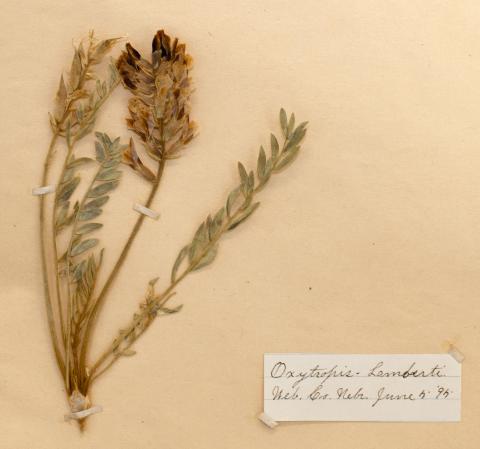
Annotations from the Archive: Herbaria of Webster County
"We were living in a world of mysterious flowers that had never been put into books, and the best we could do
was to hitch them up with some family to which they apparently belonged and invent names of our own for them."
When Willa Cather described her prairie childhood in "The Education You Have to Fight For," printed in Red Cross Magazine, 14 October, 1919 (above), she recalls with fondness the wonder of discovery. As she mentions, the Gray's Botany textbook of the day, prior to revision, lacked many of the common plants to be found on the Central Plains and to the West. Thankfully, others were quicker to offer helpful guides to students of botany. The Class Book of Botany, published in 1871 by Alphonso Wood, was a significantly updated version and was "professionally adapted to the student's use from Quebec to new Orleans and from St. Paul to St. Augustine," according to the author. The copy of Wood's book in our archival collection was the personal botany book of Frances Smith Cather, Willa Cather's "Aunt Franc," and shows heavy use. Inscribed with her name "Mrs. Geo. P. Cather" and the legal description of her homestead rather than address, we might presume that this botany book made the trip West with Franc, or was acquired soon after her arrival in Webster County. The book is also filled with handwritten plant lists, addresses of other botanists willing to trade collected specimens, and many pressed plants themselves. Also within the pages are her own children's school report cards for 1891; neither Grosvenor nor Frank were graded on Botany, but daughter Carrie was—she received an 88.
Also contained within the pages of The Class Botany was a letter written to Franc by Goodwin DeLoss Swezey, a professor in—and the director of—the Department of Natural History and Geology at Doane College. The 1891 letter answers a letter from Franc that likely regards Swezey's publication of a sixteen page pamphlet, Nebraska Flowering Plants. He notes that Franc's "list of plants growing at Otto is received, for which accept my thanks. As indicated in my circular I shall be glad to be of any assistance in settling doubtful species if good specimens are sent me." In fact, some suggestions from Swezey about classification of wildflowers of the Great Plains did become accepted within the scientific community, despite their publication in a locally-focused pamphlet form. Swezey also invented tools for measuring plant growth, compiled circulars on Nebraska butterflies and crustaceans, and collected fossils, minerals, and shells for Doane's museum collections, all before becoming professor of Astronomy and Meteorology at the University of Nebraska in 1896.
But in addition to this trove of botanical information, of course, is Franc's own herbarium. Her work in documenting the plants of northern Webster County (and occasionally eastern Franklin County) was, as noted in Swezey's letter, a contribution to the scientific record and an aid in understanding the Great Plains. Much has been done to document Willa Cather's correspondence with Reverend John Mallory Bates about locating specimens of butterfly milkweed (Asclepias tuberosa) in Webster County, but hers was not the only scientific mind in the family. Franc's herbarium consists of more than one hundred folders of plant specimens, most collected by her in Webster County in the 1890s. There are also within the collection plant specimens collected by others for "exchange," and so we may not know how many Webster County specimens Franc traded away, or—as noted by Swezey—donated to scientific study.
Our collection at the National Willa Cather Center also contains the herbarium of Lawrence Peirce, another one hundred specimens collected in 1899. Working with these herbaria reminds us how little was written about this country when early settlers to the State came West, and how they struggled to apply their Eastern educations to the lands of the West. We're inspired too, to think about how we might document and share our knowledge of our own communities today—whether we start with pressing wildflowers or documenting street art or sketching the historic buildings in our neighborhood. It all starts with curiosity.
Interested in viewing the herbaria? Make an appointment with archivist Tracy Tucker, ttucker@willacather.org. You can also schedule a guided prairie tour (but please, no specimen collecting!) by emailing our education coordinator, Rachel Olsen, rolsen@willacather.org.
